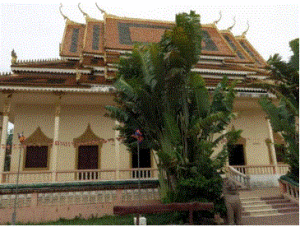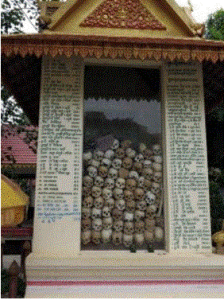Peak Sneng is one of 5 villages in a region that supports some 400 families, around 2000 people. Situated some 30 kms outside of Siem Reap, our group travelled there by bike. Peak Sneng lies on the land that 30 years ago, was one of the killing fields.
By way of portraying the significance of my visit to the village of Peak Sneng let me first take you to the Siem Reap Memorial to the Killing Fields. You’ll get a bit of Cambodia’s history as well.
Wat Thmey is located about 3 km from the centre of Siem Reap along the exit road from Angkor. If you go past the back of the Jayavaraman VII hospital established by Dr Beat Richner, (more of that later) heading out of town, it’s on the left. Most tuk tuk drivers and tour guides know it.
It is a small active Pagoda, with a not-very-inspiring statue of Buddha. The hall it’s in is quite nicely decorated and you could spend a good couple of minutes there looking around. Outside there are the homes for the monks, and a teaching hall. So far so ordinary. There’s nothing here to make you stay more than a few minutes.
However at the side of the Pagoda, is a small, rather gruesome building. Wat Thmey is home to Siem Reap’s Killing Fields’ memorial.
Since the 1400s Cambodia has been a troubled country. First the Thais sacked Angkor in 1432. Then in 1863, at the request of the King in Exile, the French took over. In the 1960s and 70s, Cambodia was subject to violent protests, and civil war. Finally in 1975, the Khmer Rouge took power. They renamed the country Democratic Kampuchea and started clearing people from towns. In a matter of hours, the entire population of Phnom Penh was ordered to leave. Many people died on the road. Everywhere people were put to work. People were killed for the slightest reason – for being too clever, (people who wore glasses were killed) through starvation, illness and the brutality that followed. Most were buried in mass graves, or simply thrown into hastily dug trenches. It is estimated that 2 million people were killed – about a third of the population at the time.
The regime was largely ousted in 1979 but Cambodia was in a state of limbo and run by the Vietnamese until 1993 when the King was restored and power returned to an elected government. Cambodia, as a modern country, is only 22 years old. There are not many old people around.
In Siem Reap, the memorial is a small building at Wat Thmey with glass windows housing the skulls and bones of some of those who perished.
It’s part of the past that many people would like to forget. But, like war memorials in Western Countries, it serves as a warning to future generations.


